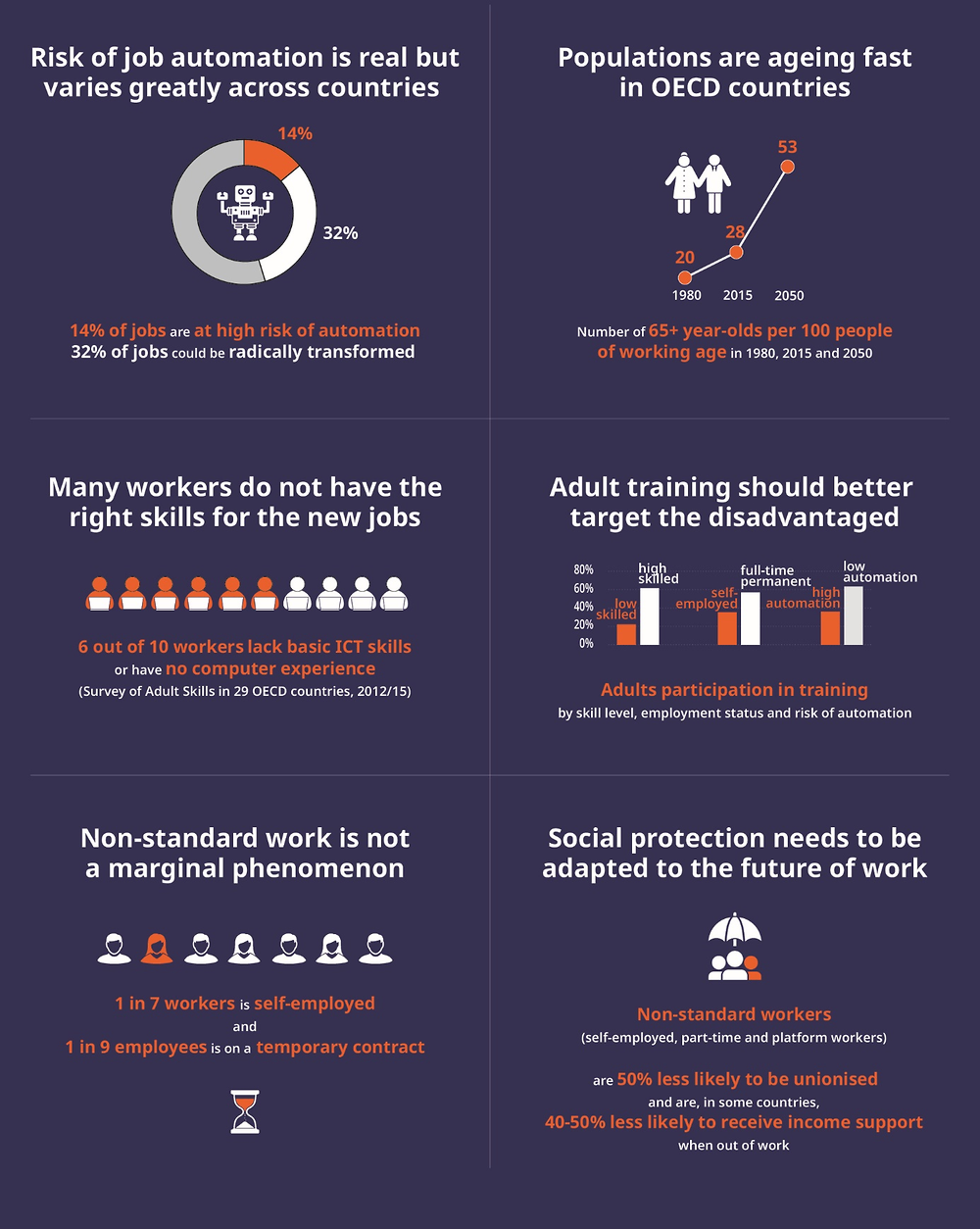Nieuwe technologieën en globalisering veranderen snel onze manier van werken en leven. Daarover is al veel geschreven, het is nu hoogste tijd voor aktie aldus de Organisatie voor Economische Samenwerking en Ontwikkeling (OESO) in de afgelopen donderdag gepubliceerde OECD Employment Outlook 2019.
Interessant om te zien hoe de media dit jaar het rapport interpreteert. Zo kopt FD dat helft banen binnen 20 jaar is verdwenen of verandert, terwijl het vorig jaar nog kopte Nederland meer ‘robotproof’ dan gedacht (met dank aan Robert Went). Cijfers over de toekomst van werk, ze blijven lastig te interpreteren. Duidelijk is inmiddels wel dat overheden, onderwijs en organisaties aktie moeten ondernemen om te voorkomen dat de ongelijkheid (met name door opleiding) toeneemt.
Het OESO-rapport is alleen voor leden te downloaden als pdf en voor de rest alleen online te lezen. De inhoud van het rapport:
Editorial: A transition agenda for a Future that Works for all
- The times they are a-changin’
- More people of working age are at work than in past decades
- Technological change and globalisation hold great promise for further improvements in labour market performance
- But people should brace for change
- A better world of work is not guaranteed – much will depend on having the right policies and institutions in place
- One thing is clear: action on the margin will not do
- Countries should assess how well current policies match priorities and prevent the most vulnerable workers from being left behind
- Shaping a future of work that is more inclusive and rewarding calls for a Transition Agenda for a Future that Works for All – a whole-of-government approach that targets interventions on those who need it most
- A Transition Agenda for a Future that Works for All requires adequate funding
- Digitalisation, globalisation and ageing bring new opportunities but also risks widening disparities among workers
- The labour market outcomes of young people without tertiary education have worsened in most countries
- All workers, regardless of their employment status, should have access to an adequate set of employment protections
- Collective bargaining can be a complementary and flexible tool to shape the future of work
- Strengthening adult learning is crucial to help workers successfully navigate a changing labour market
- Social protection reforms must ensure that support remains accessible for disadvantaged groups
- It is time for a transition agenda for a future that works for all
1. Overview: The future of work is in our hands
- Despite the many opportunities, much anxiety surrounds the future of work. Doomsday scenarios are unlikely to materialise, but there are some real risks. Many are worried that the world of work is heading for a dystopian future of massive technological unemployment, precarious work, workers with little or no bargaining power, and important skills gaps as populations age rapidly. But the future of work will largely depend on the policy decisions countries make. With the right policies and institutions in place, the opportunities that digitalisation, globalisation and longer lives will bring can be seized, and the risks mitigated.
2. The future of work: What do we know?
- This chapter discusses the key megatrends that are transforming the labour market and analyses their implications for job quantity, job quality, and inclusiveness, the three key dimensions of the OECD Jobs Strategy framework. Despite growing anxiety about potential job destruction driven by technological change and globalisation, a sharp decline in overall employment seems unlikely. There are, however, increasing concerns about the quality of some new jobs. This may increase disparities among workers if large segments of the workforce are unable to benefit from the good opportunities the economy generates. The most important challenge for policy makers is to prevent such growing disparities. Failing to do so will result in a future of work with deeper social cleavages and increasing discontent, which could have negative ramifications for productivity, growth, well-being, and social cohesion.
3. The future of work: New evidence on job stability, under-employment and access to good jobs
- The complex interplay of globalisation, technological and demographic changes is generating many new opportunities but also challenges for many workers across the OECD. This chapter provides new evidence on three selected topics that have featured prominently in the debate on the future of work: job stability, under-employment and changes in the share of well-paid jobs. The results point to worsening labour market outcomes for those with less than tertiary education and for the young in several countries. In fact, young workers with less than tertiary education stand out as a group that has experienced a pronounced decline in fortunes across a large number of countries. This raises a two-fold challenge. First, policies must promote better opportunities for school-leavers entering the labour market. Second, policies are needed to improve job prospects for the generation of young people who have faced a very tough labour market environment in the past decade.
4. Labour market regulation 4.0: Protecting workers in a changing world of work
- This chapter discusses the role of labour market regulations to adequately protect workers in a changing world of work. A key focus of the chapter is on employment status – a critical area because it acts as a gateway to various worker rights and protections. Ensuring the correct classification of workers is therefore a key first step to ensure access to labour and social protection, collective bargaining and lifelong learning. For some workers, however, there is genuine ambiguity about employment status as they find themselves somewhere in the “grey zone” between dependent and self-employment. While arguing that this grey zone should be kept as small as possible, the chapter examines the rationale and policy options for extending certain labour rights and protections to these workers. Finally, the chapter discusses the role of regulations in addressing abuses of monopsony power and rebalancing bargaining power between employers/clients and workers.
5. Facing the future of work: How to make the most of collective bargaining
- The purpose of this chapter is to identify the role of labour relations in shaping the future of work. The discussion starts by reviewing how social dialogue, and collective bargaining in particular, can be complementary and flexible tools along with labour market regulation to foster a more rewarding and inclusive future of work. This is followed by a discussion of what type of government intervention may be required to keep bargaining systems fit for purpose and make the most of collective bargaining in a changing world of work. Finally, the chapter reviews how existing institutions and social partners are adjusting to the new challenges in the labour market, as well as the role of emerging actors and new practices.
6. Making adult learning systems future-ready for all
- This chapter discusses the key role of adult learning in ensuring that all individuals can successfully navigate a changing labour market. It provides an overview of how several megatrends are changing job content and skill requirements. It identifies groups of adults that may face difficulties adapting to these changes unless they participate in re-skilling and up-skilling programmes. It also singles out workers in non-standard employment arrangements who face a number of challenges in obtaining training. For each group, the chapter discusses policy options to raise participation in training based on the specific barriers they face, be it the low quality of available training or a lack of motivation, time, money or employer support.
7. Left on your own? Social protection when labour markets are in flux
- This chapter assesses challenges for social protection policies in a changing world of work and presents evidence of support gaps in public policies affecting different types of workers. Key policy challenges include a greater need for support resulting from greater employment instability or lower earnings among some groups; a reduced accessibility or adequacy of social protection measures that were designed around stable forms of dependent employment; and sustainability challenges, e.g. due to opportunities for avoiding participation in risk-sharing provisions. Accessing adequate support can be especially difficult for workers in less secure forms of employment. But support gaps are small in some countries that adopt fairly different social protection strategies, suggesting that accessible support can be achieved with different blends of social insurance and means-tested assistance. The chapter discusses alternative reform avenues and illustrates country approaches to prepare income support and reintegration measures for the future of work.





1 reactie
OESO: nieuwe definities en regels nodig voor het grijze gebied tussen werknemer en zelfstandige
https://www.zipconomy.nl/2019/04/oeso-nieuwe-definities-en-regels-nodig-voor-het-grijze-gebied-tussen-werknemer-en-zelfstandige/